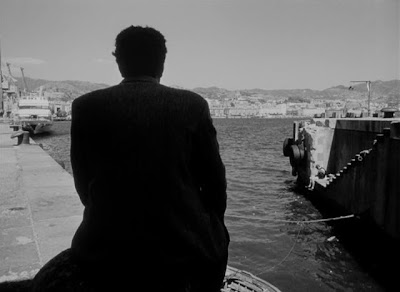 |
| Form http://nsm01.casimages.com/img/2008/01/24//080124073811194601639808.jpg |
Dirs. Masato
Tamagawa, Masatsugu Arakawa, Yasuhiro Takemoto and Yoshitomo Yonetani
The problem with Nurse
Witch Komugi is one that goes beyond the complaints taken at Japanese anime
within the last decade or so. Those complaints are still there. The
discomforting sexualisation of young girls even if they're animated. The
pandering to a small subset of otaku where the fetishes and in-jokes to anime
are alien to any outsider. Honestly even if you did have fetishes to glasses on
a woman, big breasts, maid outfits etc., or have watched obscure giant robot
shows from the seventies, you may feel a disconnect to this still. The problem
is that, for its few bright spots of imagination and clever humour, able to
mock itself too, the sum of it is the issue that faces not just anime, but any
group. Geek culture. Cult works. Hobbies. Dare I say even religion and
politics. When the quality and fun is replaced with a cheap aesthetic look and
everything feels tacky. Not fun. Extravagant. Sincere. Uplifting. Clever. Sexy.
Any potent feeling, not even kitsch. Just tacky. And such works are knowingly
tacky, which is worse because it'll encourage the followers of that areas to
just want tackiness. Within five straight-to-video episodes, including a bonus "2.5"
one, it automatically caused my heart to sink when the opening theme is a
sickly cute song, sung in too high a voice by the female singer, using medical terminology
to describe romance. The lyrics are ridiculous, the voice too high, but the
problem is how contrived it feels even when I don't speak Japanese. Too cute.
Too quirky. To the point it doesn't feel sincere. This is not something cheesy
that you can enjoy for its sincerity and because it's ridiculous, like how I've
fallen in love with the song by Loudness
from the animated box office bomb Odin
(1986) which I covered on this blog. This is just being cute because it
wants to be surface level cute and nothing more.
The anime is a spin-off from a TV series called Soul Taker (2001), which not only takes
characters from a serious work and place them in a comedy, but it became far
more popular and talked about then the original source. I have never seen an
episode of Soul Take but this isn't
a hindrance for Nurse Witch Komugi.
Now the references to anime from the past I may have to see to get some of the
jokes. Komugi is a downtrodden cosplay idol, looked down upon by her management
for continually screwing up the jobs assigned for her to become more famous. A
lot of the reason she screws up is that she has to juggle a secret alter ego,
transforming into a nurse witch to defeat the minions of a King of Germs, a
task assigned to her from a magical land of medicine with a perverted rabbit
mascot by her side. Representing the villains is a maid witch; a great idea
from the series is that she has a Dr. Jekyll and Mr Hyde personality where
neither side knows of each other, one the villain, the other Komugi's school
friend. From there it's a comedy with action but its empty. You're stuck with a
work that panders but offers nothing of real interest for a great deal of it.
Loosely connected around Komugi having to fight evil virus monsters and being a
cosplayer trying to get higher in her career choice, it boils down to a series
of absurd sketches per the six episodes but not really succeeding.
A great deal of it is arbitrary. The titillation, of course
taking cue of the magical girl genre its riffing on to show Komugi's costume
change sequence like a stripshow, is creepy because, like in most anime
unfortunately, the characters are seventeen or younger. But its creepier and perversely
lazy in how it's incredibly chaste while yet having countless bathing scenes
and the like, especially as a straight to video release. Treating sexuality in
such a compromised way yet presenting dubious sexuality in a sugar coated tone
is incredibly off for me even after all the anime I've seen. In the perfect
world, if titillation was still required, the creepy sexualisation of young
girls would be boated out in favour for grown up female characters, as much in
control of the sexual nature of the work as the viewer. Unfortunately even
then, if the lazy, chaste tone to it was kept in still, the anime would be compromised
as before. This kind of anime takes sexual fetishes and smoothens them of all
their interest and depth in favour of a checklist mentality. Big breasts. Older
women. Maid costumes. Nurse uniform. Flat chests. To decry any sexual
objectification of this sort of thing is too obvious. Decrying this sort of
anime for killing off any sense of mystery and tantalisation to sexual
fantasies, especially when animation could give one the chance to show
something completely fantastical if actually used properly for once, should be
done more often.
The same laziness is there with the references as jokes.
They're funny when you don't even need to know the references, when the jokes
already funny in context of these new characters or completely bizarre to you
because of the lack of knowledge. But like Family
Guy at its worst, it's a private conversation that isn't actually that
worth knowing the secrets of, because there's nothing beyond the surface name
checking. Moments do shine in the anime. The bosses Komugi deal with are
imaginative and funny. One representing all those otaku fetish forums, which
naturally pisses Komugi off when the "flat chest" forum, represented
by cat people, group around her. A giant robot that gets its own mecha show
theme tune sung with burning passion like the originals. Legions of road raging
vehicles that leads to a peculiar joke mocking completely CGI animation being
released around the time this was made. Even a wrestling match in Hell. And
those moments, mentioned earlier in the review, when it mocks its own industry,
while completely hypocritical considering the anime itself, do sting. Crazed
fans. The chaos of fan conventions, and an entire episode about making anime
that shows that the creators of this are masochistic about their profession.
There was the potential for something great here, but most
of Nurse Witch Komugi is not like
the good ideas presented above. Most of it responds to the most mediocre
aspects of anime in recent years, which are just dull to sit through. The final
episode tries to be fairly serious, in air quotes since its still humorous,
about a teacher witch (presumably) with breasts so large they have the
consistency of beanbags than living flesh. The lack of time in twenty or so
minutes to make something compelling, especially when the actual story is of
the episode is dull anyway, prevents it from doing anything of worth. It's
pretty much like this for most of the anime over its episodes. Brief glimpses
of goodness swallowed by the tenuous. It's kind of surprising that one of the
directors of this was Yasuhiro Takemoto,
considering looking into him he made two good comedy vignettes series, Lucky Star (2007) and Full Metal Panic? Fumoffu (2003), bearing
in mind their imperfections and that they were based around vignettes rather
than a consistent plot. The thing is thought, while Lucky Star is the superior of the two, Full Metal Panic? Fumoffu is a good comedy series which yet still
suffers from problems effecting this one - bad opening theme, creepy titillation
suddenly appearing in a later episode, and some moments that fall over badly
even if they're rare. And this was a work with clear delays between each episode,
and multiple directors working on various episodes, which unless the quality is
kept to a high level, is going to cause drops in said quality to take place. Ultimately
Nurse Witch Komugi is pretty much the
sort of thing not really worth seeing. I actually rewatched this a second time
when it came to this review, and frankly the sense that this was made for the
smallest, tiniest audience of people who have no real connection to anyone else
even in Japanese pop culture is big. And it's not good. It looks cheap, it's
not funny enough, and it does define how tacky anime can unfortunately get.
 |
| From http://pic.rutube.ru/video/33/3e/333e02e08f06fb49d6e34f95303bc03e.jpg |











































